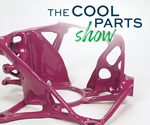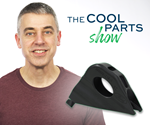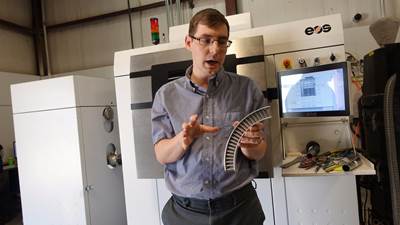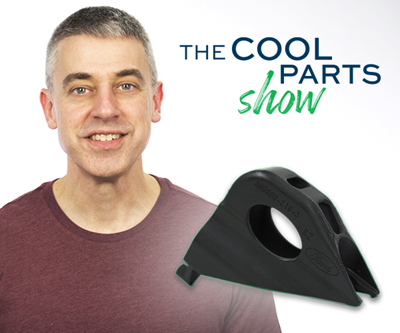Originally broadcast live, here is The Cool Parts Show’s conversation with Ceramic Disc Technology about the company’s development of a brake rotor for the Dodge Challenger Hellcat. Lattice geometry attainable only through additive manufacturing (AM) plus a special aluminum/ceramic metal matrix composite developed for AM together allow a rotor design that eliminates two-thirds of the mass, delivers five times the thermal conductivity and reduces brake dust by 95% compared to the car’s standard rotor.
Elementum3D developed the metal matrix composite material, and we hear from this company as well. The rotor was made on an EOS 400 direct metal laser sintering machine, and when it goes into full production, the part might be the largest component ever made through serial production on this platform. | This episode of The Cool Parts Show brought to you by Carpenter Additive
The Cool Parts Show is a video series from Additive Manufacturing Media that explores the what, how and why of unusual 3D printed parts. Watch more here.
Have a cool part to share? Email us.
Related resources:
- Ceramic Disc Technology
- Elementum3D
- White paper: Solidification and nucleation in aluminum alloys
- EOS 400 model
- Additive manufacturing for automotive applications
Transcript
Peter Zelinski
Stop! We're going to talk about brakes. How 3D printing and advanced materials make brake rotors better. This episode was originally broadcast live within the IMTS Spark platform. We're sharing it here as a regular episode. Brake rotors on The Cool Parts Show.
Stephanie Hendrixson
The Cool Parts Show is brought to you by Carpenter Additive. The company's Athens Alabama Emerging Technology Center is an end-to-end additive manufacturing production facility with everything from materials development through post processing under one roof, ready to help you with your next metal 3D printing job. Check them out at Carpenteradditive.com. Now, back to the show.
Peter Zelinski
Welcome to The Cool Parts Show Live.
Stephanie Hendrixson
This is our second episode through IMTS Spark. It's going to be similar to our regular show through YouTube or on our website, with the exception that our experts are here. They are going to be joining us in a few minutes.
Peter Zelinski
If you are not familiar with the show, The Cool Parts Show, this is our show about ways that 3D printing is transforming manufacturing. Every episode a cool 3D printed part, an end-use part. Find all of our episodes at The Cool Parts Show.com
Stephanie Hendrixson
Every episode is about a cool 3D printed part. Today we have this flat round, shiny thing. Pete what is our part today?
Peter Zelinski
This is a brake rotor. For car enthusiasts made by car enthusiasts. This is a brake router for a Dodge Challenger Hellcat competitive automobile. It is 3D printed, but it's also a new paradigm in brake rotors and how they should perform a typical brake rotor for this car about 32 pounds. This rotor 12 pounds significant weight savings that translates to greater acceleration, and greater fuel economy. These lattices are dramatically more effective at heat transfer. The heat transfer ability of this rotor is five times a typical rotor. Less surface area means less brake dust accumulation, 95% less, and because of the material which we'll talk about, this won't rust.
Stephanie Hendrixson
Very cool. Lots to talk about, but let's start with the basics. Who created this brake rotor?
Peter Zelinski
The company is Ceramic Disc Technologies. They are a startup, but they're a spin off out of a company that makes heat exchangers for aircraft engines. A brake rotor does a lot, but it is in effect a heat exchanger and Ceramic Disc Technologies is kind of discovering that a lot of what they know about the features that work well in a 3D printed aircraft heat exchanger also are really effective for brake rotors.
Stephanie Hendrixson
A brake rotor is a heat exchanger. I see that like you pointed out this kind of lattice structure that kind of fills the whole interior here. It looks like a heat exchanger. It has a lot of surface area that I imagine is there to help dissipate heat, but I want to ask you about something you just said the name of the company Ceramic Disc Technologies. This looks like metal to me, but is there something else going on with the material here?
Peter Zelinski
There is a lot of surface area like you say. For the heat transfer, the geometry is very significant, but aluminum, which is sort of the initial thought for how to make our lightweight rotor, an aluminum alloy is not sufficient to provide the strength necessary for these delicate features, this delicate lattice under the load that this part needs to see. This brake rotor is actually a metal matrix composite at the microscopic level, you would see that this is not purely an alloy, but it is a mixture of aluminum alloy and ceramic. The material provider, Elementum3D, are the developers of this metal matrix composite powder that is possible to apply through laser powder bed fusion.
Stephanie Hendrixson
That's interesting because you need the ceramic, and it's bringing these benefits to kind of the end application. From what I understand, it would be really difficult to try and use laser powder bed fusion with a straight ceramic. Because this is that metal matrix composite, you can print with ceramic, but you can treat it more like it's an aluminum powder. You get kind of the printability of the metal along with the benefits of the ceramic.
Peter Zelinski
Right, Elementum3D and we'll hear from them, but what they've discovered is laser powder bed fusion is actually really good for applying a metal matrix composite. The melt pool is so small that it allows the aluminum to fuse around the ceramic particulate without these constituent materials separating or settling out in any way. The result is, on a microscopic level, this very consistent structure of the material all throughout resulting in this combination that really kind of gives you the best of both worlds, the lightness, the lightweight of aluminum, the strength, and temperature properties of ceramic.
Stephanie Hendrixson
We've got the material, we've got the process powder bed fusion, what about the printer? What machine is used to make this?
Peter Zelinski
EOS 400 laser powder bed fusion machine, so big machine for this process. Let me give you a good view. The diameter of this part is such that it fills just about the entire area of the build plate of a big metal laser-based metal additive machine. When this goes into production, which it will, this is going to be a very big part for this style of additive manufacturing.
Stephanie Hendrixson
Physically a big win for additive, but I'm looking at this and like there are areas that are clearly 3D printed like this lattice surface. Then this whole top is so shiny and smooth, there has to be more to it than just the printing process right?
Peter Zelinski
Right, as with most metal 3D printed parts, the 3D printing by itself doesn't tell the whole story. Shiny surfaces, a brake rotor, so it needs fine finish, it needs really precise parallelism between the opposing surfaces, and you'd feel it in the in the drive if it didn't have those things. Precision grinding is necessary as a post processing step to complete this part.
Stephanie Hendrixson
I want to get back to something you said at the beginning. A 12-pound brake rotor versus 32 pounds, that weight savings is coming somewhat from this geometry that you can create with 3D printing. It's also coming from the material and those two things together are reducing the weight.
Peter Zelinski
Aluminum ceramic mixture has been used in brake rotors before, but it's been applied through casting. The ability to apply it through 3D printing allows for not just this lightweight material, but the lightweight material with a lightweight geometry. Those two things together allow this very light brake rotor, and the weight savings on a brake rotor in particular, are important. This is a rotating component, so particularly significant for acceleration benefits from the weight savings. This is part of the unsprung weight of the car, and when I talk about a paradigm change in brake rotors, lightweight brake rotors, previous to this four to five pounds savings would be a big win. This is about 20 pounds less per rotor as a result of additive manufacturing.
Stephanie Hendrixson
Transformative weight savings: Let's talk more about the paradigm shift here and brake rotors.
Peter Zelinski
Let's bring in our guests, our two experts. Joining us is Michael Kawecki. He's a founder of Ceramic Disc Technologies, and he's also the lead inventor of this brake rotor. From Elementum3D, our materials engineer is Adam Polizzi.
Stephanie Hendrixson
Michael, I understand that this product really kind of comes out of your passion for cars. We've been talking a lot about the weight savings, can you tell us just a little bit about the kind of driving that you do and why reducing the weight is so important?
Michael Kawecki, Ceramic Disc Technologies
The kind of racing that I do is called standing mile. It's roughly akin to a quarter mile drag racing, but whereas a quarter mile drag race is focused on the launch and elapsed time, standing mile is really about power and the trap speed or the top speed. In that racing, weight reduction is, is important or even critical. There are two kinds of weight in a car, there's fixed weight and there's rotational weight. A brake rotor obviously rotates and in a brake rotor reducing that weight, that rotational inertia or mass is highly beneficial. It occurred to me that some of the work that we were doing with other heat exchangers that I could really combine the two and ended up with the design that you have in front of you.
Peter Zelinski
Talk a little bit about that design, Michael, how you sort of validated this geometry, how you iterated and tested it what kind of tools and methods were you using there?
Michael Kawecki
One of the things that a brake rotor design has to consider is its street ability. Traditional brake rotors have to deal with all the environments out there, mud, snow, dust, dirt, rocks, that sort of thing. What we felt like was that a traditional design accommodated those factors, with too much weighting. What we felt like is we could give up some of that and gain a vastly increased surface area. You see the design; we've gone through a lot of iterations. As we did that, we did finite FEA analysis as well as thermal analysis.
Stephanie Hendrixson
Adam, I want to ask you about the material. By the time CDT came to you looking for a metal for this particular project, this metal matrix composite was one that you had already developed.
Adam Polizzi, Elementum3D
The 1000 RAM 10, which is what the CDT rotors brake rotor is built from, is commercially pure aluminum. It's actually not an aluminum alloy metal in the composite. That utilizes our patented reactive additive manufacturing or RAM. RAM utilizes our in-house production process to blend micron scale reactive constituents into the aluminum powder feedstock, and then also using the micron scale additives preserves the good feedstock flowability during the laser powder bed fusion process. With these additions in place, they react in during printing, and for submicron ceramic product phases that gave the material the added strength, stiffness, and all-around increased performance and elevated temperature that you don't get out of traditional aluminum alloys.
Peter Zelinski
Adam, it's metal 3D printing, but it's not exactly in a literal metal and I don't want to lose sight that it's a composite. I wonder if you could talk about the challenges of that. What are the challenges of laser powder bed fusion with a composite material, like it's at the at the microscopic level, say what's going on.
Adam Polizzi
One thing about the metal matrix composite in the RAM especially, is it's actually solved one of the large challenges in aluminum materials and additive. With laser powder bed fusion, one of the big challenges in the past was grain morphology or the geometry of the grains that make up the solidified material. The mechanism for part growth in powder bed fusion is in the Z direction or layer by layer. This has a propensity to form columnar grain, so it will grow skinny and tall, and literally look like New York City got smashed together. A consequence of this morphology is material property and isotropy, which is basically saying that the material has different strengths, different properties pointing this way then pointing this way which makes difficult design issues. During certification with the aluminum ram materials like a 1000 RAM 10 the ram product phases serve as a heterogeneous nucleation site or particles from which the grains can initiate growth. Rather than getting your big, tall columnar grains, you end up with grains that are the grain morphology called equiaxed which are commonly simplified as polyhedral geometries or even spherical simplified to that point.
Stephanie Hendrixson
We've talked about the material and we've talked about the design that makes this possible. I guess my last big question for Michael, as a competitive driver yourself, what kinds of performance improvements would you expect to see on a car that was equipped with these rotors?
Michael Kawecki
You've asked me the money question. It's actually very difficult to answer that question. accurately. The best answer I can give you right now is a quarter mile drag racer might see on the order of one or two tenths reduction in their elapsed time, but that might be unfair. The thing that people will tune into better than that is if you tell them that you're going to reduce their Challenger Hellcat by 75 pounds of rotational weight. They are going to hear more than anything, and for their particular car or even other cars that's huge. That's what they're really going to hear versus whether I say they're going to lose one or two tenths off their track the elapsed time.
Stephanie Hendrixson
Fair enough. I think I got this all right. This is a brake rotor for the Dodge Challenger Hellcat. It was developed by Ceramic Disc Technologies, 3D printed out of a metal matrix composites and aluminum with ceramic in it. You get the lightweight and heat transfer properties of the aluminum along with the rigidity the strength of the ceramic. It has this kind of lattice design on the inside to help with the heat transfer as well. This brake rotor is 3D printed using powder bed fusion on an EOS M 400 3D printer, and compared to traditional cast iron brake rotor for this vehicle, which weighs about 32 pounds, this one weighs only about 12 pounds, which translates into that lighter vehicle, better fuel efficiency, hopefully faster speed on the track.
Peter Zelinski
We've got time for some audience questions. We've got some questions from our audience. Michael, you said printing time for the rotor is nine to 10 hours. When this goes to market? What kind of production volume do you anticipate?
Michael Kawecki
The initial answer is that we will be able to do about 300 cars per year, but that's easily increased by simply adding additional machine capacity. For example, if we stick with one 400-4, which is where we are currently at, we'll get about 300 cars done per year. We can easily scale up: 10 machines is going to do 3000 cars a year; we go to 20, we're at 6000 cars a year.
Peter Zelinski
Next audience question is for Adam, what goes into using DMLS, or laser powder bed fusion, for ceramic aluminum? What's the process like, what kinds of laser parameters or other settings are important for working with this material? I guess Adam for someone who is used to 3D printing with say an aluminum alloy, how is the process different, the actual settings and parameters of the 3D printing process?
Adam Polizzi
The settings are similar, but they are different, because it really depends on how much of our Ram is in the blended feedstock since it is an exothermic reaction, it gives off heat. It actually helps just a little bit with the heating process from the laser. Since we can use that heat and reduce the energy of the laser we can travel faster, and actually build that at a higher rate in many cases.
Peter Zelinski
Let's do one more question and this one asks about a different brake rotor material. Michael, can you talk about the advantage of this material, this rotor design versus a carbon ceramic rotor?
Michael Kawecki
There are really two advantages to this versus carbon fiber. The first one is the big one, which is we believe we're going to be about half the price of a carbon fiber rotor. The other one is that while in some regards carbon fiber rotors are very durable, they have very high heat tolerance. They are also very fragile and are subject to chunking or cracking from impact. If you get a rock jammed up between the OD of the rotor and the caliper for example, you can tend to damage a carbon fiber rotor. If they get impacted in the wrong way with debris you can tend to crack a carbon fiber rotor, and this rotor in that regard is much more durable than a carbon fiber rotor and again probably about half the price.
Peter Zelinski
I think we'll end it there. That's all the time we have. Michael and Adam, thank you so much for joining us.
Stephanie Hendrixson
Thank you to our sponsor, Carpenter Additive. Listen to additive manufacturing podcasts, attend webinars and learn more at carpenteradditive.com
Related Content
How GM Is Investing in Additive and EVs
People within the automaker aren’t just working with additive, they are actively promoting it to their colleagues throughout the organization.
Read MoreHow Additive Manufacturing Is Transforming EVs and Transportation: AM Radio #23
As 3D printing is adopted into the electric vehicle (EV) market, it is not just vehicles that are being reshaped. In this episode of the AM Radio podcast, we discuss additive manufacturing and the future of transportation.
Read MoreSeurat: Speed Is How AM Competes Against Machining, Casting, Forging
“We don’t ask for DFAM first,” says CEO. A new Boston-area additive manufacturing factory will deliver high-volume metal part production at unit costs beating conventional processes.
Read MoreHow AM Enables Cobot Automation for Thyssenkrupp Bilstein (Includes Video)
The shock absorber maker has responded to its staffing shortages through extensive use of collaborative robots. In-house 3D printing makes this possible by providing the related hardware needed to complete the cobot-automated cells.
Read MoreRead Next
Metal Matrix Composite Demonstrates Additive Manufacturing’s Promise for New Materials
The co-founder of a materials-development firm seeks to aid manufacturers in pursuing the material freedom of AM.
Read MoreGenerative Design Improves Micromobility FUV: The Cool Parts Show #19
Arcimoto’s lightweight “Fun Utility Vehicle” gets even lighter thanks to parts that could only come from additive manufacturing. On this episode of The Cool Parts Show, some of the craziest automotive parts you have seen.
Read More3D Printing for Production at Ford: The Cool Parts Show #7
The parking brake bracket on the Mustang Shelby GT500 is now 3D printed instead of stamped. Learn how Ford is thinking about additive manufacturing in this episode of The Cool Parts Show.
Read More















